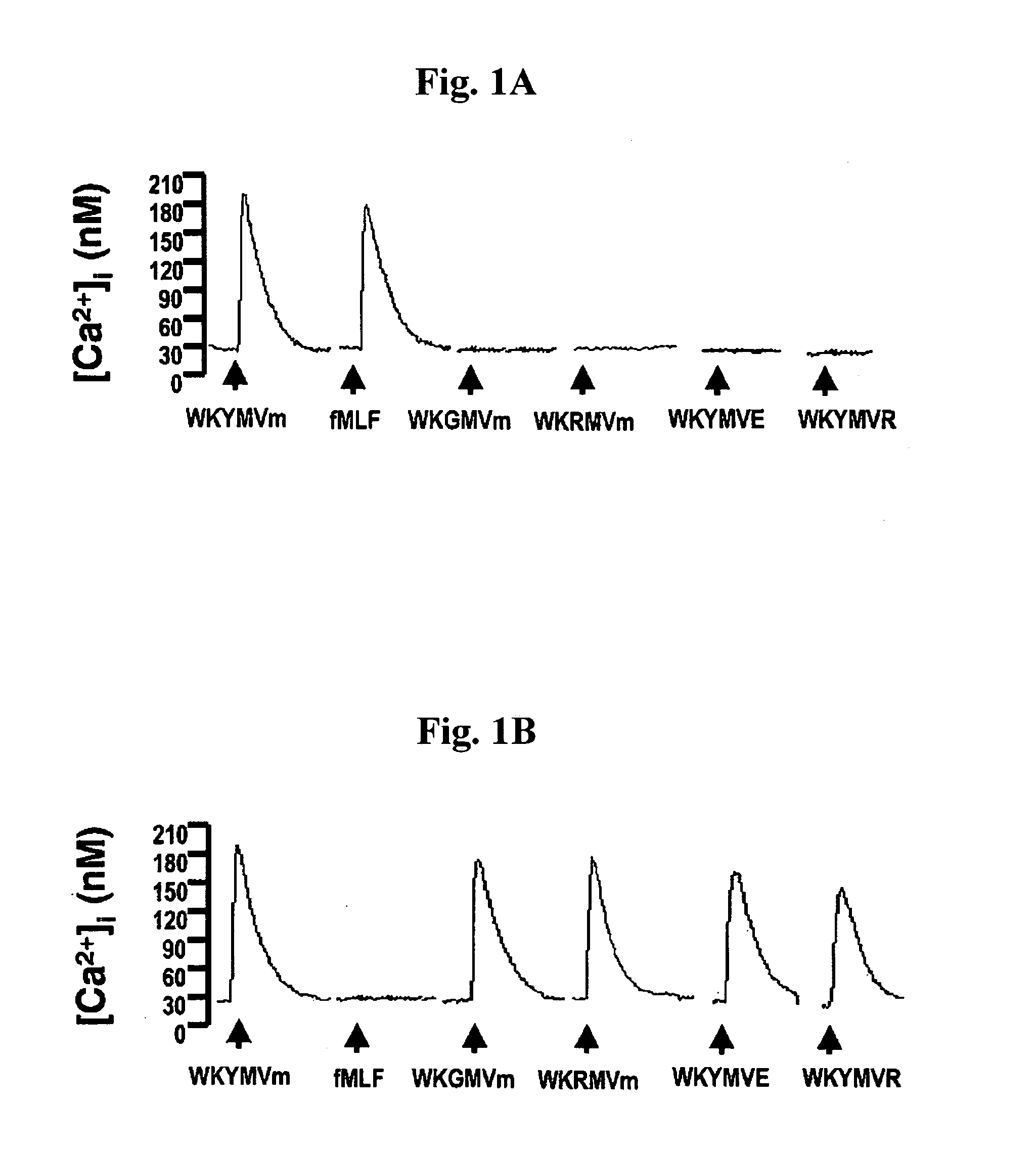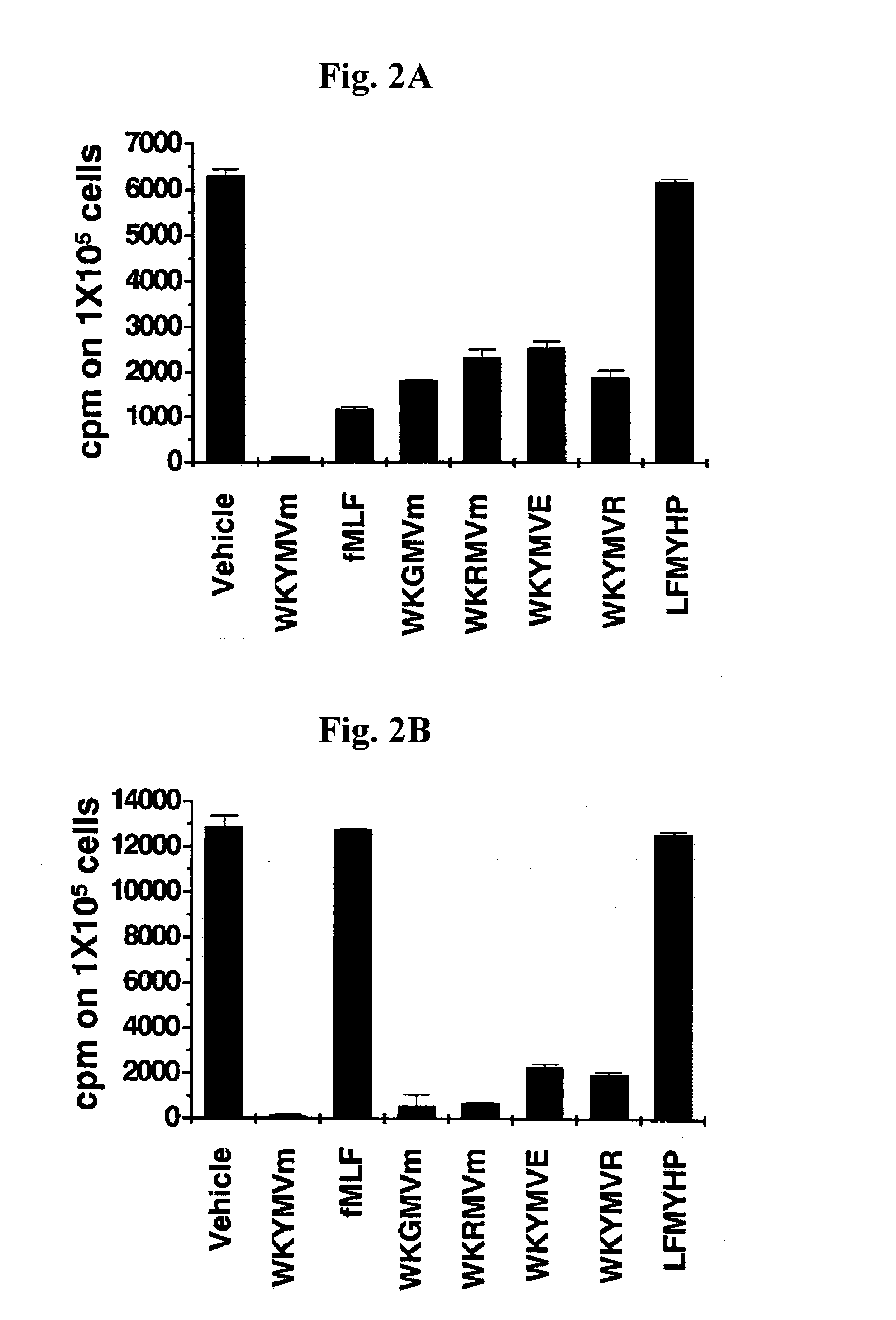Immune-modulating peptide
a technology of immunomodulating peptides and peptides, which is applied in the direction of antimycotics, depsipeptides, peptide/protein ingredients, etc., can solve the problems of provoking eventual complex immune responses, agonists induce a lot of complicated cellular signaling, etc., and achieve the effect of stimulating chemotactic migration and inducing chemotactic migration
- Summary
- Abstract
- Description
- Claims
- Application Information
AI Technical Summary
Problems solved by technology
Method used
Image
Examples
example 1
Isolation of Neutrophils
[0079] Peripheral blood leukocyte concentrates were donated by the Ulsan Red Cross Blood Center (Ulsan, Korea). Human neutrophils were isolated according to the standard procedures of dextran sedimentation, hypotonic lysis of erythrocytes, and a lymphocyte separation medium gradient as described above (9). The isolated human neutrophils were then used promptly.
example 2
Effect of Peptides on Superoxide Generation in Human Neutrophils
[0080] The activity of the peptides, WKYMVm, peptides of SEQ ID NOs: 1 to 24, and wkymvm on superoxide generation in human neutrophils was measured. Superoxide anion generation was quantified by measuring reduction of cytochrome c using a microtiter 96-well plate ELISA reader (Bio-Tekinstruments, EL312e, Winooski, Vt.) as described (14). The human neutrophils (1×106 cells / 100 μl of RPMI 1640 medium per well of a 96-well plate) were preincubated with 50 μM cytochrome c at 37° C. for 1 min and then incubated with the indicated concentrations of peptides. The superoxide generation was measured as a change in light absorption at 550 nm over 5 minutes at 1 min intervals. From at least four independent experiments, peptides with active amino acids at each position were chosen. These results are shown in Table I.
[0081] Stimulation of neutrophils with various concentrations of the peptide, WKYMVm caused superoxide generation ...
example 3
Effect of the Peptides on [Ca2+]i Increase in FPR- or in FPRL1 -Expressing RBL-2H3 Cells
[0083] The activity of the peptides, WKYMVm, peptides of SEQ ID NOs: 1 to 24, and wkymvm on [Ca2+]i increase was measured in FPR-expressing RBL-2H3 cells. FPR-expressing RBL-2H3 cells were stimulated with 10 μM of each peptide, and [Ca2+]i was determined. The level of [Ca2+]i was determined fluorometrically by Grynkiewicz's method using fura-2 / AM (15). Briefly, prepared cells were incubated with 3 μM fura-2 / AM at 37° C. for 50 min in a fresh serum-free RPMI 1640 medium under continuous stirring. 2×106 cells were aliquoted for each assay in Ca2+-free Locke's solution (154 mM NaCl, 5.6 mM KCl, 1.2 mM MgCl2, 5 mM HEPES, pH 7.3, 10 mM glucose, and 0.2 mM EGTA). Fluorescence changes at the dual excitation wavelengths of 340 nm and 380 nm and the emission wavelength of 500 nm were measured, and the calibrated fluorescence ratio was translated into [Ca2+]i. The peak level of the increased [Ca2+]i was m...
PUM
| Property | Measurement | Unit |
|---|---|---|
| width | aaaaa | aaaaa |
| pH | aaaaa | aaaaa |
| pH | aaaaa | aaaaa |
Abstract
Description
Claims
Application Information
 Login to View More
Login to View More - R&D
- Intellectual Property
- Life Sciences
- Materials
- Tech Scout
- Unparalleled Data Quality
- Higher Quality Content
- 60% Fewer Hallucinations
Browse by: Latest US Patents, China's latest patents, Technical Efficacy Thesaurus, Application Domain, Technology Topic, Popular Technical Reports.
© 2025 PatSnap. All rights reserved.Legal|Privacy policy|Modern Slavery Act Transparency Statement|Sitemap|About US| Contact US: help@patsnap.com



